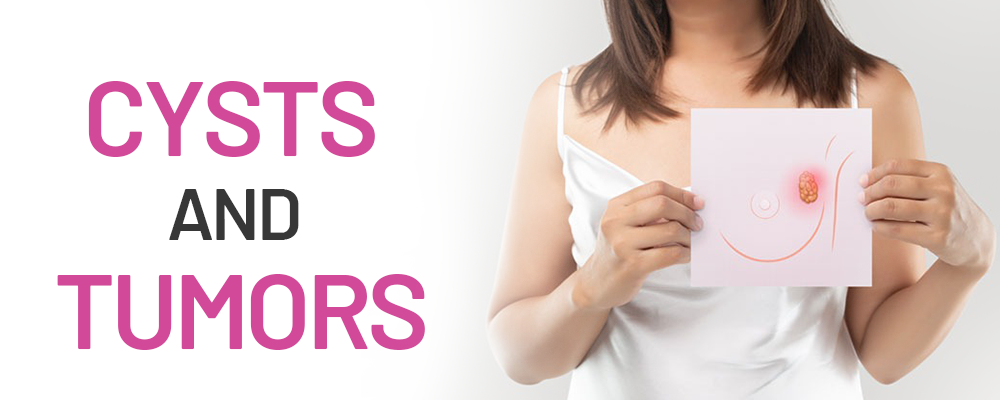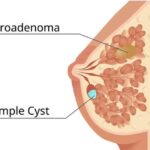
Breast lumps are recognized as a cyst (fluid-filled sac) or tumor (solid mass) and are a prominent issue for women. Though most of these lumps turn out to be harmless, some might turn out to be cancerous and claim a medical intervention. It is important to comprehend the characteristics of lumps: cysts and tumors, their signs and symptoms along with treatment, to ensure thorough breast care.
Symptoms of Breast Cysts and Tumors
- Presence of a lump or a swelling in the breast or armpit area
- Pain or tenderness (especially in the case of cysts)
- Variation in breast shape or size
- Discharge from the nipple (clear, yellow, bloody drainage)
- Nipple skin thickening or dimpling
- A movable lesion that changes position when palpated (usually a cyst)
Causes of Breast Cysts and Tumors
- Hormonal fluctuations
Increased levels of estrogen and progesterone lead to increased fluid retention resulting in formation of cysts.
These hormones also have ability to stimulate cell growth, which can lead to tumor.
- Fibrocystic breast condition
A non-cancerous condition characterized by the presence of painful lumps in the breasts due to hormonal change.
- Known Family History
Having a known family history of benign tumors might add to the risk.
- Breast Infections
Some inflammatory lumps that mimic cysts can result from mastitis or abscesses.
- Abnormal Cell Growth
Tumors, whether malignant or benign, can result from the uncontrolled growth of breast cells.
Types of Breast Cysts and Tumors
- Breast Cysts
These are usually non-cancerous fluid-filled sacs.
- Normally soft, round, and movable.
- May be painful or tender before menstruation.
- Fibroadenomas
These solid tumors made up of glandular and connective tissues are benign in nature.
- Rubbery and painless.
- Common in younger women below 30.
- Intraductal Papillomas
- They are small wart-like growths which form in the milk ducts.
- They can result in nipple discharge sometimes even with blood.
- Phyllodes Tumors
Fibrous tumors of which some are benign while others are borderline or malignant.
- Malignant Breast Tumors (Breast Cancer)
These growths are cancerous in nature and invade the neighboring tissues.
- They need to be treated medically as there is a requirement for early detection.
Diagnosis of Breast Cysts and Tumors
- Clinical Breast Exam (CBE) – The breast is examined physically by a physician.
- Ultrasound – Used to tell the difference between a cyst and solid tumors: cysts are fluid-lined.
- Mammogram – An x-ray which determines if there are any abnormal growths.
- MRI Scan – Used for cases where more details are required.
- Fine Needle Aspiration (FNA) – The cyst’s fluids are removed for further examination.
- Biopsy – Used to evaluate cancer by extracting tissue samples.
Treatment Options
Treatment for Breast Cysts
Surgical intervention is not required if there is no pain, discomfort, or benign nature.
The injection of a thin needle is used to deal with discomfort by draining fluid.
Cyst treatment associated with menstrual cycles progresses with hormonal therapy.
Treating benign tumors:
Surveillance: Some fibroadenomas resolve spontaneously.
Surgical excision (lumpectomy) for larger or progressive lesions.
Breast cancer malignant tumor treatment:
Surgical: Tumor excision (lumpectomy) or breast removal (mastectomy).
Irradiation: Destroys neoplastic cells in certain areas.
Drug therapy: Shrinks or eradicates neoplastic tissue using chemicals.
Focused medicament administration: Special attention is given to specific cancerous cells.
Consultation is required for:
New lumps that persist.
Rapidly enlarging or painful masses.
Discharge from the nipple, particulary sanguinous.
Changes in the skin: Maybe, there’s redness with dimples or pulling the skin inward.
History of breast cancer in the family.
Conclusions:
Most cysts in the breast and benign neoplasms are not dangerous for life, but at the same time, strategic differentiation betwen benign and malignant lesions is best if done as soon as possible. New lumps or abnormal changes in the breast should be seen by a specialist for further examination.
Dedicated to advanced breast conditions where early detection, precise diagnosis and treatment of the highest international standard is needed with a deep conviction that no woman should suffer from the effect of being diagnosed too late when it comes to the advanced stages of breast cancer due to late diagnosis. Let us help you with your breast care needs by booking an appointment today.
Treatments
EXCELLENTTrustindex verifies that the original source of the review is Google. Dr. Suchana is absolutely a pleasing personality and doesn't get you tense. I am glad I came to her. Besides, she doesn't run like a business and follows ethical conduct.Posted onTrustindex verifies that the original source of the review is Google. Highly recommend.Posted onTrustindex verifies that the original source of the review is Google. Dr. Suchana was great. We were late beyond 7 pm but they were so nice they waited for us and also my wife had done with all her test. Dr also gave ample time explaining us and we were at peace. I recommend Prajam.Posted onTrustindex verifies that the original source of the review is Google. The process is very humane. They are very patient and take care of all possibilities. I am glad that I found this clinic.Posted onTrustindex verifies that the original source of the review is Google. Very good experience with Dr.Suchna , she is highly knowledgeable and answers all the questions very patiently. Highly recommended for those who are looking for Breast related hospitalPosted onTrustindex verifies that the original source of the review is Google. Amazing Doctor. If you are in Prajnam (Doc Suchana) you are in safe hand.Posted onTrustindex verifies that the original source of the review is Google. Well explained and the whole Ultrasound procedure was very comfortable

